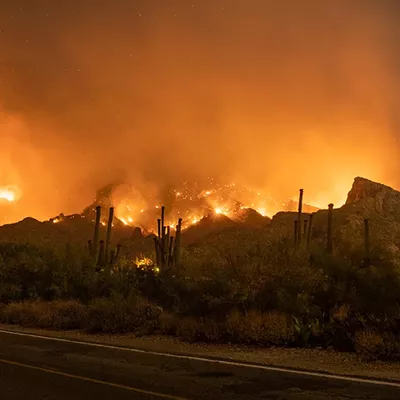Tom Van Devender can wrap his head around climate change better than most folks.
Back in the 1970s, the paleo-climatologist helped publish a pivotal study on Pleistocene packrat middens in Arizona's Lower Grand Canyon region. It turns out the ancient dens precisely traced shifting climes over thousands of years.
"They're almost like museum collections as you go through time," says Van Devender, a longtime Arizona-Sonora Desert Museum scientist who now works with the Sky Island Alliance. The wide variety of plant material left in the rodents' droppings provided a priceless record of how area vegetation had changed along with the climate.
"You could tell what the rainfall distribution was like, because you would find 90 percent winter and spring annuals (plants), and only a few summer annuals," Van Devender says. "There was really a lot of resolution."
What that resolution told him was that, as the flora around them changed with the environment, the packrats were able to adjust their diet accordingly. Other animal remains found in the middens, particularly those of reptiles, likewise revealed their broad ability to adjust to—or at least survive—drastic changes in temperature and rainfall.
Still, Van Devender is particularly cautious about using data from the past to help predict the future. What he will say is this: He doesn't expect global warming to prompt mass extinction. Nor does he expect a batch of new species to emerge from changing habitats. But he doesn't downplay the impacts of global warming, either.
"I believe there will be massive changes in geographic ranges and elevational ranges," he says, "with some readjustment of biological communities. And things are happening faster than at any other time in the recent past."
It's the unprecedented speed of that change—average global temperatures have jumped nearly two degrees since the 1880s—that makes impacts on wildlife so difficult to predict.
Researchers with the Intergovernmental Panel on Climate Change have estimated that Arizona's average temperature could rise by nearly seven degrees over this century. That's easily enough to disrupt ecosystems through rainfall fluctuation, reduced mountain snow packs and severe droughts. In other words, we could see the same transformations Van Devender glimpsed in those packrat middens, but in one century rather than many.
How that will affect Arizona's wildlife is among the many unanswered questions. The state is now home to a remarkable variety of animals, including more than 100 species of reptiles and nearly 500 types of birds—and each could be impacted in widely differing ways. According to the National Wildlife Federation, riparian habitat critical to birds such as the endangered Southwestern willow flycatcher will almost certainly decline, as will streams hosting fish such as the Apache trout.
In addition, Tucson's Center for Biological Diversity has undertaken a "350 Reasons" campaign, which cites at least 350 species expected to go extinct if atmospheric carbon dioxide—the main culprit in global warming—isn't reduced to 350 parts per million, down from the current 387 parts per million.
In Arizona, that list includes the Chiricahua leopard frog, once found in 400 wetlands and streams, but now existing in fewer than 80. It also includes the desert nesting bald eagle, which lives in increasingly shrinking riparian habitat, with nestlings particularly vulnerable to hot temperatures.
If you think this potential loss won't have any impact on your own existence, Scotty Johnson believes you might want to think again. "These aren't just species on the brink of extinction," says Johnson, who works for Defenders of Wildlife in Tucson. "This is also a huge part of Arizona's economy."
He says that outdoor recreation in Arizona is a $2 billion dollar industry, "and any impact to that needs to be averted."
But gauging the impact—both on wildlife and related tourism—is still a work in progress. Among those hoping to understand possible changes is Cecil Schwalbe, a UA ecologist who also works for the U.S. Geographical Survey's Sonoran Desert Research Station. Schwalbe is part of a team that recently won a $1.7 million grant from the agency's National Climate Change and Wildlife Science Center to study the issue.
They'll begin by looking at vegetation changes, says Schwalbe. "Then we'll try to weave into that the particular species of animals that may be affected, so that we can know how they'll react. Then we can plan our management strategies better."
Schwalbe says that studying the impacts on animals is much trickier than studying the impacts on plants. "The animals are a little more plastic in that they can usually move through two or three biotic communities. They can live in desert grasslands and move up to oak woodlands or down into Sonoran Desert scrub. Conceptually, it makes sense. But getting the data together to prove your point is not so simple."
To gauge specific effects in Southern Arizona, Schwalbe's team is conferring with the Sky Island Alliance and Pima County. "The county, with its Sonoran Desert Conservation Plan, is really into monitoring (wildlife), so we're trying to pick their brains as well," he says.
Van Devender's insights—drawn from those packrat middens—will also play a part. According to Schwalbe, they reveal that many animals can adjust to habitat changes—albeit not happily. For instance, "the vegetation changed at one site," he says, "and where it's now creosote and bursage, in the past, it was cool enough for piñon and juniper."
Surprisingly, the reptiles found in those same middens remained constant over time. "Which tells us that, in areas without an elevation variant—where they can just follow things upslope—they're kind of trapped," Schwalbe says. "But even though that may not be their preferred habitat, they can hang on and survive."
Schwalbe credits Van Devender's work for pushing biologists to question their own habitat assumptions. "Tom's work was very valuable in forcing us to think out of the box, and say, 'What in the hell were these animals doing when, in piñon-juniper, they were still able to survive?'
"The (reptiles) didn't really like it when it was that cold," says Schwalbe. "But they didn't really have any choice."
Still, under even the most optimistic projections, there will be losers. A poster child could be the alpine tundra around the San Francisco Peaks, north of Flagstaff.
"That is a doomed ecosystem under this scenario," says Schwalbe, "because that biome is already at the top of the mountain, and as it gets warmer, it will just die."









